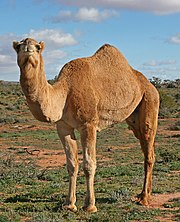Friday Eco-fact: Australia’s Feral Camels

Like many exotic species introduced into Australia, dromedary camels were brought in with the best of intentions. The camels were the first mass transit of the Great Australian Outback. In the mid-1800’s camels were shipped to Australia mostly from India to be used to ship goods and people across the Outback. What else was imported with the camels was camel herders that were responsible for driving the camels across the Outback. Even though most of the camel herders were from northern India and Pakistan these herders became popularly known as “Ghans”.
The term Ghans is so ingrained in Australian culture that when a train line was made to cross the Outback it became known as the “Ghan Train” in honor of those early camel herders:
For those who visit Alice Springs can actually see a monument to these early Outback travelers over at the train station:
However, the construction of the Ghan Train along with the construction of roads made the Outback more accessible and the use of camels obsolete. So when these early camel herders were out of work and their camels were of no use, they were simply let go. Since then the descendents of these camels have flourished in the Outback. The lowest estimates put the camel population at 500,000 while one estimate puts the camel population as high as one million. Incredibly these numbers makes Australia the home to the largest population of wild camels in the entire world. Their wild nature has also made them an export market for Australia. Middle Eastern countries prize the camels for both a food delicacy and for racing purposes.

However, since the camels are not native to Australia they are extremely damaging to the environment. They wander the Outback eating vegetation cover that small marsupials use for cover. Once the marsupials are exposed it makes them easier prey for predators thus drastically reducing their populations. They compete for grazing land and water holes with livestock which only further depletes the vegetation and reduces available water for both livestock and native wildlife. Due to these reasons, camels are widely considered a nuisance in Outback Australia. With camel populations expected to double in eight years it is clear that camels are only going to become an even bigger nuisance.


